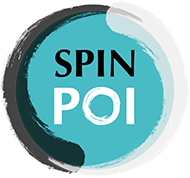FAQ
SpinPoi is located in Auckland, New Zealand, but we offer all our services online and have certified instructors across the globe. To see if there is an instructor near you, check out our instructor directory on the certifications page.
Dr. Kate Riegle van West is the Founder and CEO of SpinPoi. Kate completed her PhD in the health benefits of poi at the University of Auckland, where she conducted the first study to scientifically investigate the effects of poi on physical and cognitive function. Kate was named one of the University of Aucklands Top 40 Under 40 inspiring alumni in 2021, and was awarded the Future Leader Award from the Royal Society of New Zealand and the Best Doctoral Thesis Award for her work in the poi/health field.
Poi is a weight on the end of a flexible cord, which you swing in circular patterns around your body. Both poi the object, and how you move with that object, can take on many different forms and styles. For more information on the origins of poi and how it is used today, check out our What is Poi? page.
Yes of course! Check out our video on 3 simple ways to make poi.
Check out this page for a tutorial video on learning your first poi move and beyond, or have a look on this map for poi jams in your area.
Visit our research page, where you can read about the first clinical study on the effects of poi on physical and cognitive function. You can also read Dr. Kate Riegle van West’s full dissertation here.
Below are a few sources which might be of interest.
- Embodiment Practice: Using Poi Spinning in the Healing Process A study by Lori Sirs and Julie Meek which examines the effects of poi on self-regulation, expression, and body awareness.
- Parametric Equations at the Circus: Trochoids and Poi Flowers. An article by Eleanor Farrington about the mathematics behind poi, focused on flowers (a family of poi moves) and the transitions between them, which are naturally described by parametric equations.
- Poia mai taku poi – A history of poi: A critical review of written literature on the poi in New Zealand and the Pacific. Written by New Zealand scholar Karyn Paringatai, this book is a review of written literature on Māori Poi.
- The Rhythm and Life of Poi. A memoir by Māori poi exponent Ngāmoni Huata, which covers a variety of topics such as the spiritual heritage of poi, preparing poi, and poi in performance.
You can visit our contact page or contact us directly at [email protected]
The SpinPoi certification course is a comprehensive training designed to help you build your skillset so you can run your own poi classes.
SpinPoi’s goal in working with poi is to improve wellbeing and spread the word about poi’s positive health benefits. We work alongside tangata whenua (people of the land) and the community with cultural responsiveness acknowledging poi as ngā taonga Māori (Māori treasure). We recognize that there are many aspects of poi Māori that cannot be understood or learned in any way other than through lived experience/the passing down of mātauranga Māori (Māori knowledge). Our goal in working with poi is not to teach these aspects, but rather to work with poi as a tool to improve hauora. We believe improving wellbeing for Māori and non-Māori, especially as we age, is of utmost importance. And although the focus of our mahi is working with poi to improve health, we hope SpinPoi can also provide a space for people of all backgrounds and cultures to learn about and respectfully engage with part of Te Ao Māori (the Māori world).
